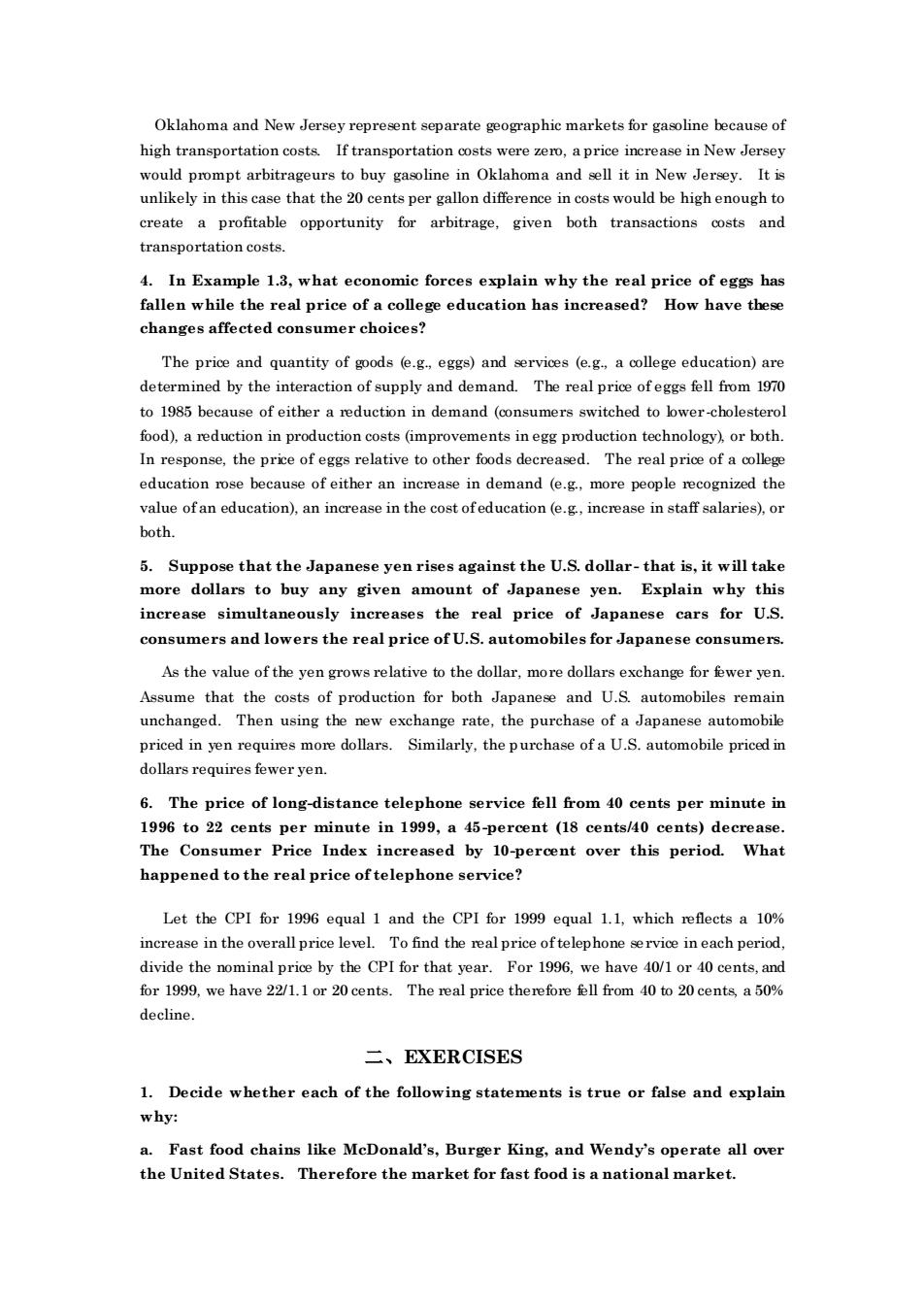正在加载图片...

Oklahoma and New Jersey represent separate geographic marketsfor gasolinebecause of high transportation costs If transportation ere,aprice nrease in would prompt arbitrageurs to buy gasoline in Oklahoma and sell it in New Jersey.It i unlikely in this case that the 20 cents per gallon difference in costs would be high enough to create a profitable opportunity for arbitrage.given both transactions costs and transportation costs. 4.In Example 1.3,what economic forces explain why the real price of eggs has fallen while the real price of a college education has increased?How have thes changes affected consumer choices? The price and quantity of gods e.g.eggs)and services (e.g.a oollege education)are determined by the interaction of supply and demand.The real price of eggs fell from 1970 to 1985 because of either a reduction in demand (consumers switched to lower-cholesterol food),areductionin production costs (improvements inegg production technology)or both. toother foods dec ed.The real price ofa col education because of either an increase in demand (e.g more people recognized the value of an education),an increase in the cost ofeducation (e.g,increase in staff salaries),or both. 5.Suppose that the Japanese ven rises against the U.s.dollar-that is.it will take more dollars to buy any given amount of Japanese yen.Explain why this increase simultaneously increases the real price of Japanese cars for U.S. con sumers and lowers the real price of U.S.automobiles for Japanese consumers As the value of the yen grows relative to the dollar,more dollars exchange for fewer yen Assume that the costs of production for both Japanese and U.S.automobiles remain unchanged.Then using the new exchange rate,the purchase of a Japanese automobile priced in yen requires more dollars.Similarly,the purchase of a U.S.automobile priced in dollars requires fewer yen. 6.The price of long-distance telephone service fell from 40 cents per minute in Coasumer Price Index increased by 0-percent over this period.wh 5-percent (18 cents/ cents) ecrea happened to the real price oftelephone service? Let the CPI for 1996 equal 1 and the CPI for 1999 equal 1.1,which reflects a 10% increase in the overallprice level.To find the real price oftelephone service ineach period. divide the nominal price by the CPI for that year.For 1996,we have 40/1 or 40 cents,and for 1999.we have 22/1.1 or 20 cents.The real price therefore fell from 40 to 20 cents a 50% decline. 二、EXERCISES 1.Decide whether each of the following statements is true or false and explair why: a.Fast food chains like MeDonald's,Burger King,and Wendy's operate all over the United States.Therefore the market for fast food is a national market.Oklahoma and New Jersey represent separate geographic markets for gasoline because of high transportation costs. If transportation costs were zero, a price increase in New Jersey would prompt arbitrageurs to buy gasoline in Oklahoma and sell it in New Jersey. It is unlikely in this case that the 20 cents per gallon difference in costs would be high enough to create a profitable opportunity for arbitrage, given both transactions costs and transportation costs. 4. In Example 1.3, what economic forces explain why the real price of eggs has fallen while the real price of a college education has increased? How have these changes affected consumer choices? The price and quantity of goods (e.g., eggs) and services (e.g., a college education) are determined by the interaction of supply and demand. The real price of eggs fell from 1970 to 1985 because of either a reduction in demand (consumers switched to lower-cholesterol food), a reduction in production costs (improvements in egg production technology), or both. In response, the price of eggs relative to other foods decreased. The real price of a college education rose because of either an increase in demand (e.g., more people recognized the value of an education), an increase in the cost of education (e.g., increase in staff salaries), or both. 5. Suppose that the Japanese yen rises against the U.S. dollar- that is, it will take more dollars to buy any given amount of Japanese yen. Explain why this increase simultaneously increases the real price of Japanese cars for U.S. consumers and lowers the real price of U.S. automobiles for Japanese consumers. As the value of the yen grows relative to the dollar, more dollars exchange for fewer yen. Assume that the costs of production for both Japanese and U.S. automobiles remain unchanged. Then using the new exchange rate, the purchase of a Japanese automobile priced in yen requires more dollars. Similarly, the purchase of a U.S. automobile priced in dollars requires fewer yen. 6. The price of long-distance telephone service fell from 40 cents per minute in 1996 to 22 cents per minute in 1999, a 45-percent (18 cents/40 cents) decrease. The Consumer Price Index increased by 10-percent over this period. What happened to the real price of telephone service? Let the CPI for 1996 equal 1 and the CPI for 1999 equal 1.1, which reflects a 10% increase in the overall price level. To find the real price of telephone service in each period, divide the nominal price by the CPI for that year. For 1996, we have 40/1 or 40 cents, and for 1999, we have 22/1.1 or 20 cents. The real price therefore fell from 40 to 20 cents, a 50% decline. 二、EXERCISES 1. Decide whether each of the following statements is true or false and explain why: a. Fast food chains like McDonald’s, Burger King, and Wendy’s operate all over the United States. Therefore the market for fast food is a national market